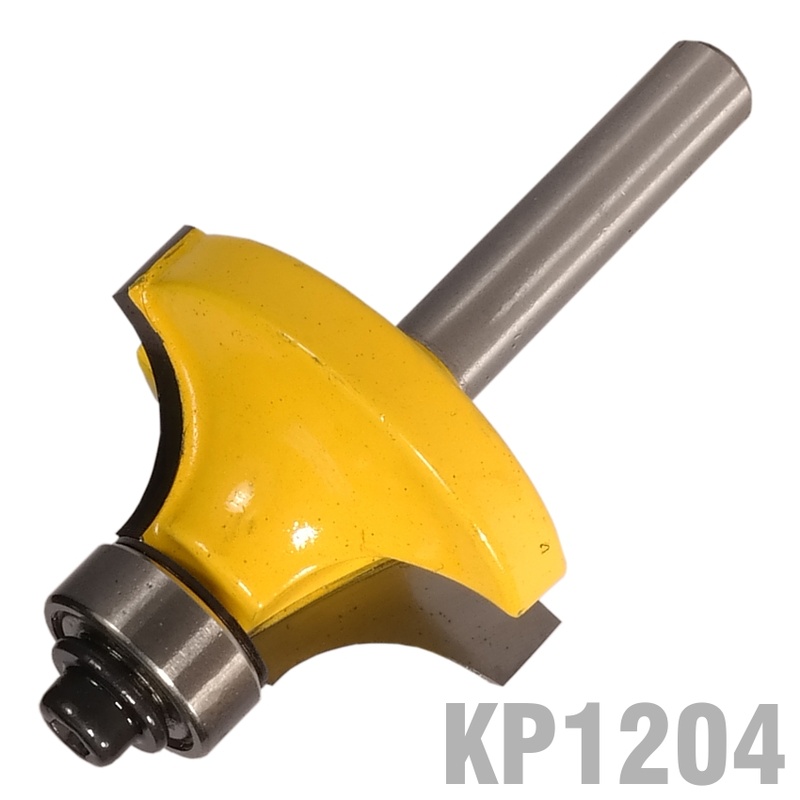

R431.80
 Corner
Round Router bit
Corner
Round Router bit

The corner-rounding bit rounds an edge to a given radius. The tool is shouldered to cut a fillet if required. The cut can be used to ease edges, as a simple profile, or as a part of a complex one. Other names for this router bit are round-over, rounding over and quarter-round. If a smaller pilot bearing is used, a second shoulder can be produced, in effect making the bit a beading bit.
Rounded edges give a project a softer, smoother look. The greater the radius of the round-over, the more pronounced this effect becomes.
 Rounding
an edge makes it more durable because it won't show dents, splinter, or lose its
finish as easily as a sharp corner. Like a blade that loses its sharp edge, a rounded
corner is more 'friendly' to people or objects that come in contact with it.
Rounding
an edge makes it more durable because it won't show dents, splinter, or lose its
finish as easily as a sharp corner. Like a blade that loses its sharp edge, a rounded
corner is more 'friendly' to people or objects that come in contact with it.
Manufacturers classify round-over bits according to the radius they cut. So, a 3/8 inch round-over bit cuts a 3/8 inch radius, and so forth. To determine the radius of a round-over bit, measure either of the dimensions shown in the drawing.
This router bit has a 6,35 mm shank (shaft) that will fit most small or large routers. Please ensure that you select a router bit with a shank (shaft) size that will fit into your router collet.
PRO-TECH router bits are manufactured in Taiwan.

| consider safety for your health and the people around you | |||
General safety suggestions:It is advisable to always have the following items nearby and in a good condition
|
|||
|
|
|
|
|
|
Wear Gloves
|
Eye Protection
|
Hearing Protection
|
Dust Mask
|
To use router bits safely (and to get the best results from your router), the router bits need to be installed properly into the router's collet. Improper installation of your bits can cause excessive chatter and could increase the likelihood that the bits will break when in use.
First of all, before beginning any routing operation, check your bits to make sure that they are clean, relatively free of pitch, and most of all, sharp. If the bit is dull, chipped, is excessively burned or has any other defect, it should be sharpened or replaced before use.
 Correct
collet and collet nut fit
Correct
collet and collet nut fitMost router collets have a recess (groove) that needs to click into a circlip that resides inside the collet nut. Failing to ensure that the collet 'clicked' into the collet nut will cause you to struggle to remove the router bit after tightening. This could cause the collet to break or be removed by a technical repair centre.
 Correct
fit inside the collet
Correct
fit inside the colletWhen installing the bit into the collet, do not tighten the collet with the bit 'seated.' Instead, insert the bit until the shank (bit shaft) reaches the bottom of the collet, then ease it out about 2 mm before tightening the collet.
When the bit is tightened, there should be no less than 2/3 's of the length of the shank in the collet. If your bit has a shank that is too short, then the bit should be replaced.
There are a few other safety measures to keep in mind whenever you use your router. First of all, remember to always wear appropriate safety gear as indicated above.
Second, be sure to set your router to the proper speed for your router bit. Setting your router to an incorrect speed will not only affect the router's performance, but also can cause the bit to break much more easily and even cause bodily harm. The speed at which a router bit turns can be important. The typical router runs at about 22,000 rpm, which is fine for most bits. But as the diameter of the bit increases, you’ll want to slow things down.
Also, before beginning any routing operation, be certain that you give the router's motor time to come up to full speed for the chosen setting. Beginning to cut before the bit is at full speed can give less than desired results.
 Observe
the following at all times
Observe
the following at all times Always
be sure the router is unplugged before replacing bits and that the switch is
off before connecting the router.
Always
be sure the router is unplugged before replacing bits and that the switch is
off before connecting the router. Keep
hands and fingers away from revolving bits and cutters.
Keep
hands and fingers away from revolving bits and cutters.  Don't
operate a tool if you are tired or under the influence of medication, drugs,
alcohol or while smoking.
Don't
operate a tool if you are tired or under the influence of medication, drugs,
alcohol or while smoking. 
